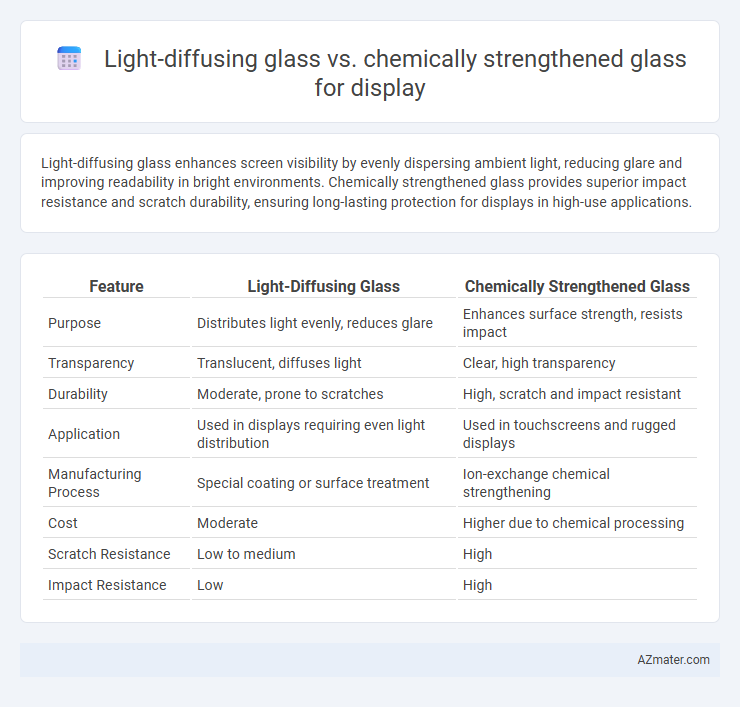Light-diffusing glass enhances screen visibility by evenly dispersing ambient light, reducing glare and improving readability in bright environments. Chemically strengthened glass provides superior impact resistance and scratch durability, ensuring long-lasting protection for displays in high-use applications.
Table of Comparison
| Feature | Light-Diffusing Glass | Chemically Strengthened Glass |
|---|---|---|
| Purpose | Distributes light evenly, reduces glare | Enhances surface strength, resists impact |
| Transparency | Translucent, diffuses light | Clear, high transparency |
| Durability | Moderate, prone to scratches | High, scratch and impact resistant |
| Application | Used in displays requiring even light distribution | Used in touchscreens and rugged displays |
| Manufacturing Process | Special coating or surface treatment | Ion-exchange chemical strengthening |
| Cost | Moderate | Higher due to chemical processing |
| Scratch Resistance | Low to medium | High |
| Impact Resistance | Low | High |
Introduction to Display Glass Technologies
Light-diffusing glass enhances display visibility by scattering light to reduce glare and improve viewing angles, making it ideal for outdoor or bright environments. Chemically strengthened glass, using ion-exchange processes, significantly increases surface strength and scratch resistance, ensuring durability and longevity in touchscreens and handheld devices. Both technologies address distinct challenges in display performance, balancing optical clarity with mechanical resilience to meet diverse application needs.
What is Light-Diffusing Glass?
Light-diffusing glass disperses light uniformly across the display surface to reduce glare and enhance visual clarity, improving user experience in various lighting conditions. Unlike chemically strengthened glass, which primarily increases toughness and resistance to scratches and impacts, light-diffusing glass enhances optical performance by scattering light evenly. This technology is essential for displays in environments with high ambient light, ensuring consistent image quality and reducing reflections.
What is Chemically Strengthened Glass?
Chemically strengthened glass is a type of safety glass treated through an ion-exchange process, enhancing its surface compression and making it significantly more resistant to scratches and impacts compared to standard glass. Unlike light-diffusing glass, which scatters light to reduce glare and improve legibility on displays, chemically strengthened glass maintains high transparency and clarity while providing superior durability. This combination makes chemically strengthened glass ideal for touchscreens and mobile device displays that require both optical clarity and physical robustness.
Optical Properties Comparison
Light-diffusing glass offers enhanced glare reduction and uniform light distribution, improving readability under bright lighting conditions. Chemically strengthened glass provides superior scratch resistance and mechanical strength but maintains higher transparency with less diffusion, resulting in sharper image clarity. The choice between the two depends on whether optical softness or durability and image sharpness is prioritized in display applications.
Mechanical Strength and Durability
Chemically strengthened glass offers superior mechanical strength through ion-exchange processes that enhance surface compression, making it highly resistant to impacts and scratches, ideal for durable displays. Light-diffusing glass, while not primarily designed for strength, integrates microstructures that scatter light effectively but typically exhibits lower mechanical robustness compared to chemically strengthened variants. For display applications demanding high durability and mechanical resilience, chemically strengthened glass remains the preferred choice due to its enhanced toughness and resistance to mechanical stress.
Impact on Display Performance
Light-diffusing glass enhances display readability by reducing glare and improving contrast through uniform light distribution, which is particularly beneficial in high ambient light conditions. Chemically strengthened glass improves display durability by increasing surface strength and scratch resistance, but may slightly affect optical clarity due to internal stress layers. Selecting between the two depends on the priority of visual performance versus mechanical protection in display applications.
Applications in Modern Displays
Light-diffusing glass enhances display visibility and reduces glare by scattering ambient light, making it ideal for outdoor digital signage and automotive heads-up displays. Chemically strengthened glass offers superior scratch resistance and durability, commonly used in smartphones, tablets, and wearable devices to protect touchscreens from impact and daily wear. Integration of both materials can optimize image clarity and device longevity, meeting diverse demands in modern display technologies.
Cost and Manufacturing Considerations
Light-diffusing glass typically incurs higher manufacturing costs due to complex surface treatments and coating processes that scatter light uniformly, enhancing display visibility under various lighting conditions. Chemically strengthened glass offers cost advantages through its ion-exchange process, which increases durability and scratch resistance without extensive post-production treatment, simplifying manufacturing. While light-diffusing glass demands precision in coating application, chemically strengthened glass benefits from standardized production methods, making it more economical for large-scale display manufacturing.
Environmental and Sustainability Aspects
Light-diffusing glass enhances display visibility while often requiring additional coatings or treatments that may impact recyclability, posing environmental challenges. Chemically strengthened glass, produced through an ion-exchange process, offers superior durability and longer lifespan, reducing the frequency of replacement and electronic waste generation. Both glass types contribute to sustainability, but chemically strengthened glass typically supports a lower environmental footprint due to its enhanced resistance to damage and potential for reuse in electronic displays.
Choosing the Best Glass for Display Requirements
Light-diffusing glass enhances visibility by scattering light uniformly, reducing glare and improving readability in high ambient light conditions, ideal for outdoor or bright interior displays. Chemically strengthened glass offers superior durability and scratch resistance due to ion-exchange processes, making it suitable for touchscreens and high-impact environments requiring robust protection. Selecting the best glass depends on balancing optical performance for clarity and diffusion against mechanical strength and damage resistance based on specific display use cases.

Infographic: Light-diffusing glass vs Chemically strengthened glass for Display
 azmater.com
azmater.com